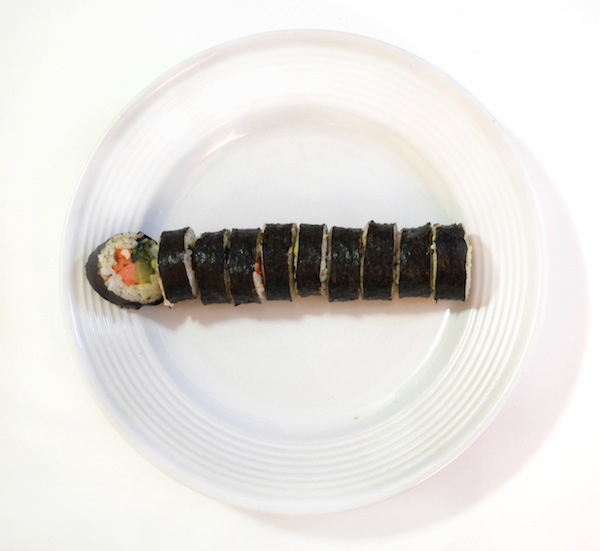Monday, November 11, 2013
Kimchi (김치)
Make your own kimchi (김치)! Kimchi, fermented napa cabbage, is Korea's national dish. Traditionally, it was stored in a jar and allowed to ferment underground. You can find kimchi in stores, but it usually has shrimp paste or fish sauce in it. This recipe is relatively simple and easy to do yourself. You can eat kimchi as a side dish, and it's also used in a variety of dishes like kimchi stew (김치찌개; kimchi jjigae) or kimchi fried rice (김치볶음밥; kimchi bokkeumbap). You can find Korean chile powder, essential for this dish, at a Korean grocery store. Check to make sure it is from Korea.
Monday, October 14, 2013
Doenjang Jjigae (된장 찌개)
Sunday, September 29, 2013
Hobakjuk (호박죽)
It's officially fall, the perfect time for hobakjuk (호박죽), kabocha squash porridge. Hobak (호박) means squash and juk (죽) is the character for porridge. The farmer's market near me had a ton of kabocha squash in season. I like to add balls of sweet rice flour or you can add in sweet rice flour to thicken the porridge, but you can leave the flour out and it will still taste good. I love to eat this dish for breakfast in the fall.
Sunday, September 15, 2013
Songpyeon (송편)
September 20th is Chuseok (추석), an yearly harvest festival in Korea held around the Autumn Equinox, at which songpyeon (송편), a half-moon shaped rice cake, is traditionally eaten. It is steamed with pine needles, which lend their selves to the songpyeon's fragrance and taste. The character song (송) stands for a pine tree. It comes in different colors and is usually filled with sugar, honey, and sesame seeds or sometimes chestnut or mung beans.
There aren't many pine trees in NYC where I can just pick pine needles off of. I went to US Evergreen in the flower district, and they let me take a pine bough for free. Use non-glutinous rice flour (쌀가루 or 쌀떡가루), which is usually in the frozen section, and not glutinous sweet rice flour to make the songpyeon. It's said that if you make pretty songpyeon, you'll have a pretty daughter. I say just try your best to make it look like a half moon.
Sunday, August 25, 2013
Buchujeon (부추전)
My favorite Korean side dish is buchujeon (부추전), a savory pancake featuring buchu (부추) or Chinese chives. Buchu tastes more like garlic than chives and has flat, thin leaves. It is also used to make buchu kimchi.
Sunday, August 18, 2013
Dotorimuk muchim (도토리묵무침)
Before the summer weather is over, I wanted to share my favorite dish to eat in summer, dotorimuk muchim (도토리묵무침), seasoned acorn jelly. The acorn jelly is traditionally made from acorns gathered from oak trees in mountain forests. The actual process for hulling the acorns is pretty difficult.
Now, you can buy acorn starch at Asian supermarkets, which you can make into acorn jelly. Be careful with the amount of water you put in and the cooking time. If there's too much water in the acorn jelly after it solidifies, it's slightly mushy and bitter tasting.
Sunday, August 4, 2013
Japchae (잡채)
For every birthday in my family, we always eat japchae (잡채), a dish made from sweet potato noodles. It is usually served at special occasions. While it is sometimes served with beef, japchae originated as a vegetarian dish. The name includes the characters jap (잡) meaning "mixed" and chae (채) meaning "vegetables" (the same character in the title of this blog). Thus, japchae literally means "mixed vegetables."
The current version of this dish includes sweet potato noodles and usually has mushrooms, spinach, and carrots. You can find sweet potato noodles at most Asian supermarkets, or you can serve this dish without the noodles, just make sure to reduce the seasonings or add more vegetables to balance out the flavors.
Tuesday, July 30, 2013
Kimbap (김밮)
Summer is the time for picnics, and my favorite Korean dish to eat outdoors is kimbap (김밮) or "seaweed rice." As you can see above, it is similar to a sushi roll. The dish originated during the Japanese occupation of Korea. It has evolved from sushi, however, and is now a distinct Korean dish that is sold everywhere in Korea at food stands.
There are many variations featuring fish cakes, imitation crab meat, eggs, beef, or even spam. I like kimbap with just vegetables, but it also tastes great with tempeh or ground seitan if you want to add more fillings. Pickled yellow radish is essential to kimbap, and you should be able to find it at most Asian grocery stores. You will also need a bamboo rolling mat to make the rolls. While it's tricky at first to roll the kimbap, it gets easier, and I find it fun to do.
Sunday, July 21, 2013
Bulgogi (불고기)
Welcome to Chaeshik, a blog featuring homestyle Korean vegetarian and vegan recipes. Chaeshik (채식) means a vegetarian diet in Korean. I love Korean food and have been a vegetarian for about five years. Being a Korean-American vegetarian is a little difficult since Koreans love their meat, but there are delicious Korean dishes featuring vegetables or that can easily be made vegetarian or vegan.
For my first blog entry, I am posting about bulgogi (불고기), one of the more popular Korean dishes. It is a simple and hearty dish that I remember eating often growing up. It is traditionally marinated meat that is grilled and literally means "fire meat" in Korean. This version features seitan and lots of garlic. Serve with rice or romaine lettuce and wrap the seitan in the lettuce.
Subscribe to:
Posts (Atom)








